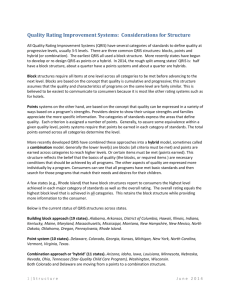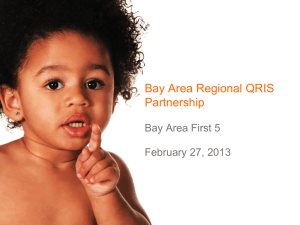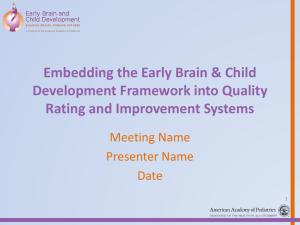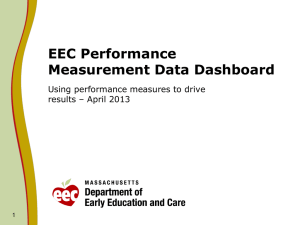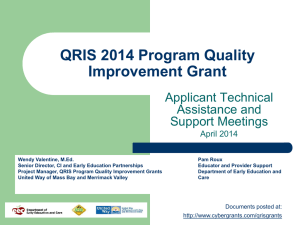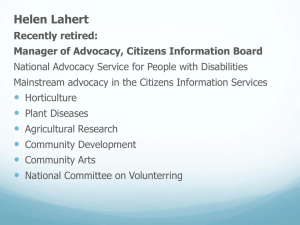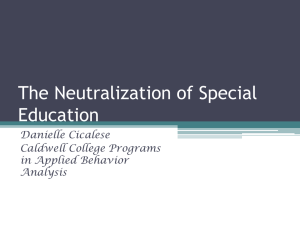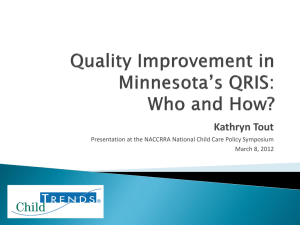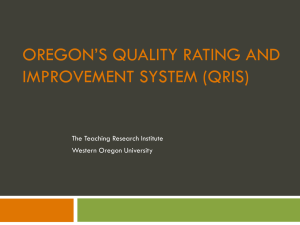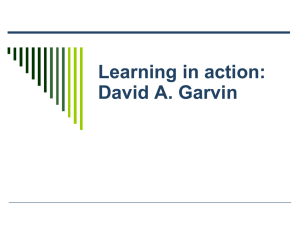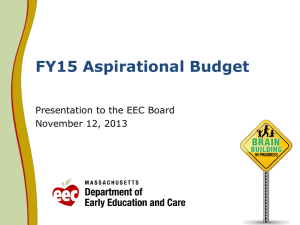QRIS and Early Childhood Special Education PowerPoint
advertisement
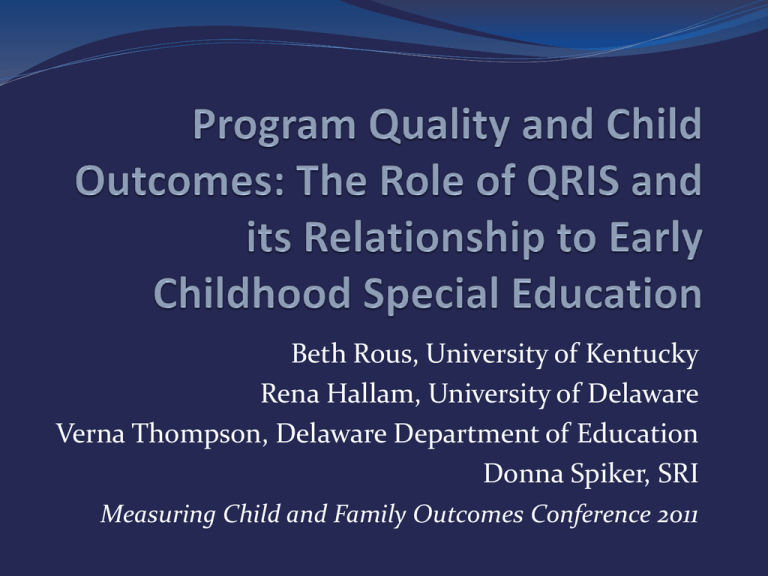
Beth Rous, University of Kentucky Rena Hallam, University of Delaware Verna Thompson, Delaware Department of Education Donna Spiker, SRI Measuring Child and Family Outcomes Conference 2011 Session Overview QRIS from a national perspective (Beth) Delaware’s experiences (Rena and Verna) Future possibilities (Donna) Discussion (All) What is a QRIS? Common Elements Quality standards Process for assessing/monitoring standards Outreach and support to programs Financial incentives Consumer awareness http://nccic.acf.hhs.gov/qrisresourceguide QRIS Across the U.S. Quality Standards Licensing compliance Administration and Ratio and group size Health and safety Curriculum Environment Child assessment Director, teacher, provider qualifications Family partnership management Cultural and linguistic diversity Accreditation Provisions for children with special needs Community involvement Assessing Observed Quality in QRIS 23 of 26 states with QRIS use an observation measure of quality Most use the Environment Rating Scales (ERS) A few (e.g., Virginia, Minnesota) use the Classroom Assessment Scoring System (CLASS) Individual states use other measures Children with Special Needs 8 of 26 states address for centers 6 of 26 states address for family child care homes Specialized training Screening procedures Planning for children with special needs Documentation of plans & activities Environmental accommodations RTT-Early Learning Challenge QRIS Program Standards Early learning and development standards Comprehensive assessment system Early childhood educator qualifications Family engagement strategies Health promotion practices Effective data practices Absolute priority about Children with High Needs Resources http://www.acf.hhs.gov/programs/opre Compendium of Quality Rating Systems and Evaluations State Profiles Rena Hallam Delaware Institute for Excellence in Early Childhood, University of Delaware Verna Thompson Delaware Department of Education September, 2011 Presentation Outline Overview of Delaware Stars for Early Success Historical Perspective on QRIS development and integration with services for young children with disabilities Current Status of Delaware Stars Framework for QRIS redesign and next steps Delaware Stars Voluntary QRIS implemented in 2007 to serve all types of licensed child care in Delaware. 5 Star Levels with successive quality requirements in four program areas: Learning Environments and Curriculum Program Administration and Management Family and Community Partnerships Professional Development and Qualifications Benefits of program participation include: Technical Assistance Grants and Awards **Tiered Reimbursement to be implemented October, 2011 Historical Perspectives on Initial Development Vision (2005) All of Delaware’s children and families will have access to quality early care and education from birth through school-age. One of the primary reasons for creating QRIS system in Delaware Provide quality learning environments for children with disabilities and children at risk QRIS standards Initial Standards- Indicator for serving children with disabilities (staff training on inclusion, implementing IEP activities) Later standards -Removed indicator for disabilities and embedded information in standards Current Status of Delaware Stars Challenges in participation rates and program movement through the star levels New Governor’s initiative in early childhood increased subsidy rates and created a tiered reimbursement system Stars in currently in a redesign and ramping up phase. Current Participation and Ratings (n=181) Star Level Designation 100 90 80 70 60 50 40 30 20 10 0 SL 1 SL 2 SL 3 SL 4 SL 5 AP What Have We Learned? Many programs are getting “stuck” at low levels of the rating system Too much focus on paperwork, too little focus on practice Great variability in accessing resources and supports from Delaware Stars Providers need more flexibility and more responsive TA System is struggling to improve quality of care for all children Foundation for QRIS Redesign Practice Principles Continuity of Care Inclusive Practice Intentionality Systems Principles Increase visibility of state infrastructure to promote quality Align quality infrastructure in ways that makes sense to programs Collaboration with Key Stakeholders Implementation Principles Use data to inform technical assistance Use recommended technical assistance practices; diversify our strategies Engage programs more effectively State Quality Infrastructure Early Learning Foundations Personnel Competencies Delaware Early Childhood Career Lattice PROGRAM QUALITY Current Collaborative Efforts between QRIS and Services for Young Children with Disabilities Inclusion of new indicators related to young children with disabilities across all four dimensions of program quality in QRIS Indicator Review – state-level review and input from crossagency Expanding Inclusive Early Intervention Opportunities (EIEIO) group Support for Inclusion Credential for child care personnel Sharing QRIS information with 619 providers – TA opportunities Next Steps for Delaware Race to the Top Early Learning Challenge Grant Application QRIS system needs to include programs serving children with disabilities Increased emphasis on recruitment and support to programs serving high proportions of low-income children Stars “Plus” Higher intensity support to high need programs delivered in a cohort model Measuring Quality of ECE Programs for Children with Disabilities Donna Spiker Measuring & Improving Child & Family Outcomes Conference, New Orleans, LA September 2011 Quality Framework Based on a book chapter: Spiker, D., Hebbeler, K., & Barton, L. (2011). Measuring quality of ECE programs for children with disabilities. In M. Zaslow, K. Tout, T. Halle, & I. Martinez-Beck (Eds.), Measuring quality in early childhood settings. (pp. 229-256). Baltimore, MD: Paul H. Brookes Publishing Company. Four types of participation in the ECE system for young children with disabilities A C1 B Integrated program General early care and education (GECE) Discrete programs C2 IDEA supports and services (EI/ECSE) Critical quality questions Does this general early care and education (GECE) program provide a high-quality experience for children with disabilities? Does this EI/ECSE program provide high-quality services? Are the GECE program and the EI/ECSE program coordinating well to provide a high-quality experience for children with disabilities? Considerations related to measuring program quality for children with disabilities Common elements of quality (DAP) such as: Instructional practices to promote learning Teacher-child interactions Assessment practices Use of materials & physical environment Individualization: Adaptations & accommodations Program quality versus Individualized quality Implementing the child’s OFSP or IEP Parent Partnerships Proposed framework for program quality for children with disabilities: Major areas, with related concepts and examples Major Area # 1. Interactions Interactions with peers Interactions with adults Major Area #1. Interactions: Related concepts and examples Presence of typically developing children Adult facilitation and support of child’s interaction with peers Adult use of appropriate techniques to address challenging behavior Adult implementation of specialized techniques to facilitate language development Major Area # 2. Program features Curriculum Instructional practices Scheduling Nature of activities Materials Major Area # 2. Program Features: Related concepts and examples Curriculum modifications and adaptations Instructional practices geared to child’s needs Use of everyday routines to promote development and learning Availability of specialized materials Full engagement of child in activities Implementation of IFSP/IEP Developmentally appropriate and functional goals Integration of specialized services Major Area # 3. Staff characteristics & program structure Staff education Staff training Experience Beliefs Goals Child-to-staff ratios Group size Arrangement of physical space, equipment, furnishings Major Area #3. Staff characteristics & program structure: Related concepts and examples Professional development for staff related to children with disabilities in general and to the child’s special needs in particular Staff support for inclusion Reduced ratios for classes with a special needs child Assistive technology, adapted equipment, modified physical space Major Area # 4. Administrative characteristics Philosophy (program goals, beliefs about children, families, and early education Structures (policies, compensation) Context (funding adequacy, accreditations, connections to other agencies) Supports (professional development activities, availability and quality of specialists, supervision of staff) Major Area #4. Administrative characteristics: Related concepts and examples Policy voicing support for inclusion Zero reject policy Coordination between general and specialized programs/services Access to specialists Time provided to support team planning Transdisciplinary service provision Major Area #5. Parent partnerships Communication Program support for family outcomes Family-centered practices Major Area # 5. Parent partnerships Related concepts and examples Services and supports designed to help parents support child’s development and learning Staff use of parents’ knowledge of child’s strengths, needs, and interests Ongoing communication to support continuity of experiences for child between home and center Important decisions related to child’s programs or services made jointly by parents and providers Few measures to examine program quality for children with disabilities Two assessment tools designed to measure inclusive program practices for children with disabilities: SpeciaLink Child Care Inclusion Practices Profile and Principles Scale Quality Measures of Inclusive Experiences Measure (QuIEM) Questions?
